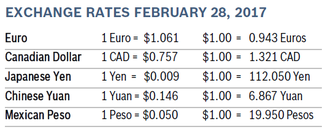|
All three indexes recorded gains for the month of February, with the DOW recording 12 days of consecutive record closes before falling back slightly the last day of the month. The DOW soared past the 20,000 mark, closing at 20,812, up 4.8% for the month. The NASDAQ closed at 5,825, up 3.8% and the S&P, the index most closely followed by economists, closed at 2,364, up 3.7%. CONSUMER CONFIDENCE RISES TO 114.8 The New-York based Conference Board’s Consumer Confidence Index rose to 114.8 in February after dropping to 111.6 in January. Consumer confidence is at a 15-year high. The Present Situation Index rose to 133.4 from an upwardly revised 130.0 and the Expectations Index increased to 102.4 from 99.3 in January. Overall, consumers expect the economy to continue to expand. Consumers’ assessment of current conditions held relatively steady in February, and they were more optimistic about the short-term outlook. The percentage of consumers expecting business conditions to improve over the next six months increased from 22.9% to 24.0%. Economists say a level of 90 indicates that the economy is on solid footing and a level of 100 or more indicates growth. Analysts caution that the real driver behind consumer spending is income growth and that labor market trends are a more accurate predictor of consumer behavior. CONSUMER SPENDING RISES 0.2% Consumer spending rose 0.2% in January after rising 0.5% in December. Core consumer spending, which is adjusted for inflation, fell 0.3% in January after rising 0.3% in December. It was the first drop in core spending since last August and the biggest decline in three years. Personal income rose 0.4% in January after rising 0.3% in December, making for twelve consecutive months of gains. In the 12 months through January the PCE price index advanced 0.4% after rising 0.2% in December. The core PCE price index, which is the Fed’s preferred measure of inflation, rose 0.3% in January after rising 0.1% in December and was up 1.7% in the 12 months through January. Consumer spending is closely watched by economists because it accounts for 70% of U.S. economic activity. CONSUMER PRICES RISE 0.6% The Consumer Price Index (CPI) rose 0.6% in January after rising 0.3% in December and was up 2.5% over the past 12 months. It was the biggest monthly increase since February 2013, and about double what economists were expecting. Core inflation, which excludes food and energy, was up 0.3% in January after rising 0.2% in December and was up 2.3% over the past year. Core inflation has been in a range between 2.1% and 2.3% since December 2015. The rising cost of gasoline, up 7.8%, was once again the biggest factor in the increase in the index in January. The energy portion of the CPI was up 10.8% over the last 12 months, the largest 12-month increase since November 2011. UNEMPLOYMENT FALLS TO 4.7% The U.S. economy added a healthy 235,000 jobs in February and the unemployment rate fell to 4.7% from 4.8% in January. Job gains for December were revised down and gains for January were revised up, resulting in an additional 9,000 more jobs than initially reported. Hourly wages rose by 6 cents to $26.09 in February, after a 5-cent increase the month before. The labor force participation rate was little changed at 63.0%. Construction employment increased by 58,000, with gains in specialty trade contractors (+36,000) and in heavy and civil engineering construction (+15,000). Construction has added 177,000 jobs over the past 6 months. Retail lost 26,000 jobs in February. The healthy jobs report surpassed economists' expectations and likely cleared the way for the Federal Reserve to raise interest rates at their meeting in March. Fed Chair Janet Yellen has said the economy needs to create just under 100,000 jobs a month to keep up with growth in the working-age population. DURABLE GOODS ORDERS RISE 1.8% Durable goods orders rose 1.8% in January after falling by a downwardly revised 0.8% in December. Economists had expected orders to increase 1.7%. The rise came after two consecutive months of declining orders. Orders excluding transportation, which can be a highly volatile category, dropped 0.2% in January after an upwardly revised 0.9% increase in December. Capital goods orders for nondefense items excluding aircraft, which are seen as a proxy for business spending, fell 0.4% in January after rising 0.8% in December. Shipments of non-defense capital goods excluding aircraft, which are used in the calculation of GDP, dropped 0.6% in January after surging an upwardly revised 1.6% in December. The durable goods report is often both volatile and subject to sharp revisions. Wells Fargo believes the stall in January is likely temporary, and expects orders and manufacturing activity to continue to firm in 2017. CHICAGO PMI RISES TO 57.4 The Chicago PMI rose to 57.4 in February after falling to 50.3 in January, rising well above analysts' consensus of an increase to 53.0. It was the strongest reading since January 2015. New orders rebounded strongly and moved back into positive territory for the month and production rose to a 13-month high of 60.3. The prices paid index rose to 68.6 from 61.4, the highest level since September 2014. Order backlogs also increased, but remained below the break-even level of 50.0 for the third successive month. Inventories were up strongly. Supplier deliveries fell to the lowest level in four months, which analysts say could suggest capacity issues, and the PMI’s employment index moved into expansion for the first time in four months. More significantly, it was the highest employment reading for the index since October 2014. The February reading marked the ninth month of expansionary business activity in the U.S. WHOLESALE PRICES RISE 0.6% The producer price index (PPI) rose 0.6% in January after rising 0.3% in December. It was the largest advance since the fall of 2012. Wholesale prices were up 1.6% from January 2016. Wholesale prices for gasoline jumped 12.9% in January and 32.3% over the past year. Rising energy costs have recently become a prime source of inflation, reversing a trend in recent years in which falling oil prices were suppressing inflation. Excluding energy, food and services for wholesaling and retailing, producer prices increased just 0.2% in January. The PPI for inputs to construction rose 0.7% in January after rising 0.7% in December and was up 3.1% over the past year. Steady consumer demand and more stable commodity costs are expected to keep producer prices moving upwards; the strong dollar could moderate increases. Q4 GDP RISES 1.9% GDP growth in the fourth quarter was unchanged at 1.9%, according to the Commerce Department’s second estimate, but consumer spending for the quarter was revised up to 3.0% from the previously estimated 2.5%. Economists had expected GDP growth would be revised up to 2.1%. The upward revision to consumer spending helped offset modest downward revisions to business investment spending and state and local government spending. The big gain came from spending on healthcare services, which was revised up and contributed 0.66% to overall growth of 1.9%. GDP FORECASTS President Donald Trump has set a goal of doubling growth to 4% annually through an ambitious stimulus program of tax cuts, deregulation and infrastructure spending. Economists think 4% growth is very ambitious, but many have raised forecasts based on Trump’s stated policies and objectives, and some private economists now think GDP will grow 2.4% this year and 2.7% in 2018. The New York Federal Reserve’s Nowcast model projected U.S. economic growth for the first quarter at about 3.1%, which would track to an annualized pace of 3.09%. The members of the Economic Advisory Committee of the American Bankers Association expect GDP growth this year to be 2.2%, and growth next year to be around 2.7%. JOB OPENINGS STEADY Job openings held steady in December at 5.5 million according to the Job Openings and Labor Turnover Survey, or JOLTS. Excluding education, state and local government openings declined by 85,000. The number of unemployed job seekers per opening held steady at 1.4. For full year of 2016, hires totaled 62.5 million and separations totaled 60.1 million, with a net gain in employment of 2.4 million. The number of people who quit their job dropped by 98,000 in December, bringing the quits rate back down to 2.0%. A rising quits rate signals increasing worker confidence in the labor market and generally leads to faster wage growth. The JOLTS report is one of Fed Chair Janet Yellen’s preferred economic indicators. FED COULD RAISE RATES IN MARCH Many economists are predicting that the Federal Reserve will raise interest rates as early as their March meeting, based on a series of strong economic reports in January. Fed Chair Janet Yellen told the House of Representatives that the central bank does not want to fall behind a fast-growing economy and be forced to raise rates quickly. Economists say that Yellen’s cautious approach also means that the Fed is not likely to move too quickly. Economists also point out that the Fed could end up at odds with President Trump because a tax cut or infrastructure-led stimulus could boost the economy further, leading the Fed to tighten rates more rapidly. That, in turn, could make it hard for Trump to reach the 4% annual growth he’s promised. FED CALLS GROWTH DISAPPOINTING Janet Yellen said that economic growth has been “very disappointing” when she presented her first monetary policy report to a House panel since the presidential election. Yellen defended the Fed’s record, noting that 16 million jobs have been added since the economy bottomed out, unemployment has fallen below 5% and annual inflation is at 1.6%. However, the economy only expanded 1.5% in 2016. Fed governor Daniel Tarullo announced he is leaving the board in early April. Two seats on the seven member board have been open for nearly three years. Tarullo’s departure will give President Trump three Fed positions to fill. Yellen also pledged to work with Treasury Secretary Steven Mnuchin to fulfill an executive order from Trump to review federal financial laws and regulations. Some members are urging the repeal of Dodd-Frank, passed after the banking crisis to hold banks more accountable. Yellen told senators that Dodd-Frank has restored the banking system to safety and profitability. She said that regulations are not a key factor in restraining economic growth, and also warned that a radical change in the government’s policy on immigration could pose an economic risk and affect the potential for the economy to grow. © Robert Bosch Tool Corporation. All rights reserved, no copying or reproducing is permitted without prior written approval.
Comments are closed.
|
|








